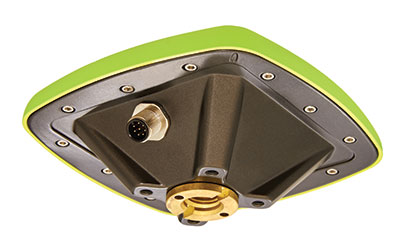Javad GNSS has launched a new field receiver based on the technology implemented in its Triumph-3 chip, which was introduced in May.
The MCAnt-3S receiver hosts 874 GNSS signal channels, allowing it to track all current and future GNSS signals. It can be mounted on flat surfaces with four screws or mounted on standard poles.
MCAnt-3S combines the receiver with a high-performance GNSS antenna in a compact and robust housing that is easy to mount, making it suitable for machine control applications. Communication is provided via CAN 2.0, USB 2.0 and RS-232/RS-422 interface.
MCAnt-3S 874 All-In-View Channels
- GPS C/A, L1C (P+D) including TMBOC (6,1,4/33), P1, P2, L2C (L+M), L5 (I+Q)
- GLONASS C/A, P1, P2, L2C, L3 (I+Q)
- Galileo E1 (B+C) including CBOC (6,1,1/11), E5A (I+Q), E5B (I+Q), Alt-BOC, E6 (B+C)
- QZSS C/A, L1C ( P+D) including TMBOC (6,1,4/33), L2C (L+M), L5 (I+Q), L6 (L61/L62), L1S, L1Sb, L5S
- BeiDou B1, B1C (P+D) including TMBOC (6,1,4/33), B2B (I+Q), B2, B2A (I+Q), AltBoc, B3
- IRNSS L5
- SBAS L1, L5 (P+D)
Of the 874 channels in the Triumph-3 chip, 864 are general purpose GNSS channels and 10 are additional QZSS LEX channels. Each general-purpose channel consists of 10 correlators and a memory-code engine that allows reception of all existing GPS, GLONASS, Galileo, QZSS, WAAS, EGNOS and BeiDou signals with BOC and Alt-BOC capability. The memory-code engine is designed for existing truncated PN-code signals as well as future signals.
Before reaching the GNSS channels, the navigation signal goes through a sophisticated RF data-processing module. This module performs digital filtering of input signals to divide the spectrum by several frequency bands (L1, L2, L5, etc).
The module contains two special-purpose filters: an anti-jamming filter based on an adaptive LMS algorithm and a classic FIR filter to suppress static interference.
The fast-acquisition module combines four independent modules, each of which can search very long navigation signals (up to 16,284 symbols) with a sensitivity of -150 dBm and run as the equivalent of 130,000 correlators.
